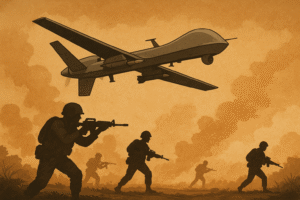Drone Warfare and International Law: Reassessing Legality in the Age of Targeted Strikes

A symbolic illustration of modern drone warfare, highlighting the tension between technology, legality, and accountability
Drones, also known as unmanned aerial vehicles (UAVs), are aircraft that are remotely controlled and used for military operations such as targeted bombings or missile attacks. There is numerous definitions of drone attack but the definition provided by the International Bar Association’s Human Right Institute (IBAHRI) is mostly used in jurisdictive matters while debating on drone attack IBAHRI defined it as “Drone attacks involve the use of unmanned aerial vehicles (UAVs) delivering lethal weapons against targets, often non-state actors, in foreign territories”
While the use of drones in warfare has a relatively short history, it has gained significant attention and criticism in recent years. The Israeli military was the first known to use drones for military purposes, specifically for reconnaissance missions, in the 1980s. The US military also started using drones for surveillance and targeted killings in the 1990s, but it wasn’t until the early 2000s that the use of drones for targeted killings became more widespread.
One of the most well-known users of drone strikes is the US, which has conducted drone strikes in a number of countries, including Syria, Afghanistan, Pakistan, Somalia, and Yemen. The US government has argued that drone strikes are a necessary tool for combating terrorism and that they are more precise and cause fewer civilian casualties than other forms of military action. However, critics have raised concerns about the legality and accountability of drone strikes, as well as the number of civilian casualties that have resulted from them.
Legal framework deal with Drone Attacks:
There are two main legal basis which deal with drone attack, the “Jus ad Bellum,”
and “International human rights law (IHRL)” these three frameworks deal with the regulation of use of force, human right concern and customary international rules.
Jus ad Bellum:
The Jus ad Bellum is law which based on the codes of “UN Charter” which regulates the use of force and also administer the limitation and circumstance under which a state has the option for use of force against another state, or against non-state actors present in its territory. Jus ad Bellum is based on core principle of ‘UN Charter” such as “the respect of sovereignty and territorial integrity, allowances of self-defense and use of force.”
Jus ad bellum deal with two articles of UN charter the Article 2(4) “which prohibit the threat or use of force against the territorial integrity or political independency of any state.” So, these articles prohibit both threat or use of force and breaching the sovereignty of sate while the other one the ‘” Article 51”’ that talk about the notion of Self- defense under which It provide the code by which state can use force against another state.
Moreover, the real concern is interpretation of these article, state interpret this article according to serve their own interest. In context of “legality of a drone attack under jus ad bellum” it is subject to whether this action is justified by article 51” Self-Defense” or permission it meets the principle of necessity, proportionality, and distinction. Although, such notions are often contested and interpreted differently by different states and scholars, and they may not always align with the requirements of IHL and IHRL.
International human rights law (IHRL):
The legality of a drone attack under IHRL depends on whether it violates the right to life or other human rights of the individuals affected by it, and whether it provides due process, judicial review, and effective remedies for the victims and their families. However, these rights and obligations are also challenged and limited by the applicability and extraterritoriality of IHRL, and by the interaction and integration of IHRL with IHL.
The main concern in given legal frameworks was the application of “principle of distinction” while targeting the militant groups and the civilian and non-combatant causalities which are also mentioned in the Common Article 3 of the Geneva Conventions protects civilians or persons who are not actively or in any form taking part in the conflict between two contracting parties. Moreover, the additional protocol II of the Geneva Conventions allows the use of force against the NSA and against those who are taking part in any form of conflict, but under certain conditions such as, it should have a proper code of conduct, and holding territory.
The relationship between the notion of distinction and drones
The deployment of drones for directed assassination raises various questions concerning the concept of distinction, that also compels sides to a military confrontation to discriminate between fighters and innocent and to aim strikes solely against fighters and military facilities.
One issue is the question of who is responsible for ensuring that the principle of distinction is respected when drones are used for targeted killing. In the case of traditional military operations, the responsibility for respecting the principle of distinction typically lies with the military forces on the ground, who are physically present in the area of operations and can observe the situation firsthand. In the case of drone strikes, however, the operators of the drones may be located thousands of miles away from the target, relying on video feeds and other remote sensors to gather information about the target and the surrounding area. This can make it more difficult to accurately assess the situation on the ground and to ensure that the principle of distinction is being respected.
Another issue is the potential for civilian casualties in drone strikes. While drones can be equipped with precision-guided weapons that can minimize the risk of civilian casualties, there is still a risk that civilians may be caught in the crossfire or that the intelligence supporting a particular strike may be incomplete or inaccurate.
Finally, there’s the issue of responsibility and transparency in drone strikes. Some claim that the use of drones for selective targeting is more hidden and less accountable than regular military operations, making it more difficult to ascertain whether the principle of distinction is being followed and hold those responsible for breaches accountable. This has prompted calls for more inclusiveness and transparency when it comes to using drones for targeted assassination.
legality of drone attacks under jus ad bellum using the example of US drone attack on Syria:
The U.S justified its Drone attack on Syria by two main legal frame frameworks, the first is “unwilling and unable doctrine” which is controversial concept in international law that deals with the use of force by a state against non-state actors (NSAs) on the territory of another state. The doctrine claims that a victim state has the right to engage in lawful extra-territorial self-defense when the host state is unwilling or unable to suppress the threat posed by the NSAs. The doctrine has been invoked by several states, such as the United States, France, and Turkey, to justify their military interventions in Syria against the Islamic State of Iraq and the Levant (ISIL).
Secondly the US justified the drone attack by using article 51 the right of self-defence against the Islamic State of Iraq and the Levant (ISIL), a non-state actor that poses a threat to the US and its allies. The US invokes Article 51 of the UN Charter, which recognizes the inherent right of individual or collective self-defence if an armed attack occurs against a member of the UN. However, the legality of this claim is disputed by some states and scholars, who argue that the right of self-defence only applies to attacks by states, not by non-state actors, and that the US drone attacks violate the sovereignty and territorial integrity of Syria, a member of the UN.
Illusion or compliance with the concept of distinction?
Countless articles have surfaced of civilian fatalities as a consequence of drone attacks, and some people have wondered whether the required steps are always followed to reduce the potential of injury to people. Some have criticized the use of “signature strikes,” wherein citizens are aimed based on their behavior or other markers instead of their authenticity, claiming that this approach can result in the targeting of participants who are not genuine military targets and might not even be actively involved in violence.
Concerns have also been raised regarding a lack of transparency and accountability in the use of drones for targeted killing. It has been difficult in certain situations to gather reliable information regarding the number of civilian victims and the circumstances of specific strikes, making it impossible to determine whether the principle of distinction has been observed. This lack of openness has also made holding those responsible for any infractions accountable more difficult.
Overall, while the use of drones can, in theory, allow for more precise targeting and minimize the likelihood of innocent causalities when compared to other forms of military involvement, there are issues that the concept of distinction might not always be sufficiently respected in practice, as well as the concept of distinction might not always be appropriately recognized in practice.
The utilization of drones for aimed killing has been criticized because it puts a strain on the principle of distinction, a core principle of international humanitarian law (IHL) that requires participants to an armed confrontation to differentiate between noncombatants and soldiers and only direct attacks against military objectives. Many claim that the usage of drones follows the principle of distinction because of their accurate technology, which allows only authorized military objectives to be attacked.
However, closer examination reveals that this may not always be the case. If the principle of distinction is interpreted broadly to focus on the precision of the weapon rather than the precision of the process used to employ it, this can lead to an increase in drone strikes and, as a result, a higher number of civilian casualties and potential violations of the principle of distinction.



